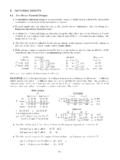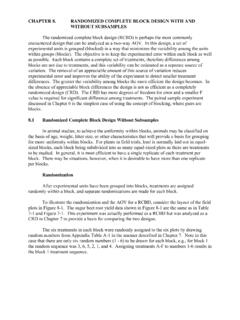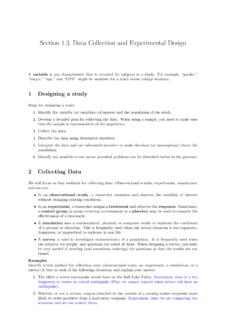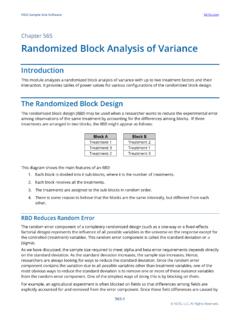Transcription of Tests for Homogeneity of Variance
1 For Homogeneity of Variance In an ANOVA, one assumption is thehomogeneity of Variance (HOV)assumption. That is, inan ANOVA we assume that treatment variances are equal:H0: 21= 22= = 2a. Moderate deviations from the assumption of equal variances do not seriously affect the results in theANOVA. Therefore, the ANOVA is robust to small deviations from the HOV assumption. We onlyneed to be concerned about largedeviations from the HOV assumption. Evidence of a large heterogeneity of Variance problem is easy to detect in residual plots. Residualplots also provide information about patterns among the Variance . Some researchers like to perform a hypothesis test to validate the HOV assumption. We will considerthree common HOV Tests : Bartlett s Test, Levene s Test, and the Brown-Forsythe Test. These Tests are not powerful for detecting small or moderate differences in variances. This is okaybecause we are only concerned about largedeviations from the HOV Bartlett s Test To perform Bartlett s Test:1.
2 CalculateU=1C[ ln(s2p) i=1a iln(s2i)]wheres2p= ai=1 is2i , i=ni 1, =a i=1 i, C= 1 +13(a 1)(a i=11 i 1 ).Note: for a oneway ANOVA,s2p=MSEand =N RejectH0: 21= 22= = 2aifU > 2( ,a 1). Bartlett s Test is the uniformly most powerful (UMP) test for the Homogeneity of variances problemunder the assumption that each treatment population is normally distributed. Bartlett s Test has serious weaknesses if the normality assumption is not met. The test s reliability is sensitive (not robust) to non-normality. If the treatment populations are not approximately normal, the true significance level can bevery different from the nominal significance level (say, =.05). This difference depends on thekurtosis (4th moment) of the distribution. The true significance level will be smallerthan the nominal level for a distribution withnegative kurtosis (such as a uniform distribution). The true significance level will be largerthan the nominal level for a distribution withpositive kurtosis (such as a double exponential distribution).
3 Because of these problems, many statisticians do not recommend its use. They recommend Levene sTest (or the Brown-Forsythe Test) because these Tests are not very sensitive to departures Levene s Test To perform Levene s Test:1. Calculate eachzij=|yij yi |.2. Run an ANOVA on the set Ifp-value , rejectHoand conclude the variances are not all equal. Levene s Test is robust because the true significance level is very close to the nominal significancelevel for a large variety of distributions. It is not sensitive to symmetric heavy-tailed distributions (such as the double exponential and stu-dent stdistributions). Brown-Forsythe Test To perform the Brown-Forsythe Test:1. Calculate eachzij=|yij yi|where yiis the median for Run an ANOVA on the set ofzij Ifp-value , rejectHoand conclude the variances are not all equal. The Brown-Forsythe Test is relatively insensitive to departures from normality.
4 It is not sensitive to skewed distributions ( , 2) and extremely heavy-tailed distributions ( ,Cauchy). In these cases, it is more robust than Levene s Example of Bartlett s, Levene s, and Brown-Forsythe TestsA textile company has five looms that weave cloth. The company is concerned that there may be significantvariability in the strengths of the cloth produces by the looms. Five random samples of cloth are takenfrom the cloth produced by each loom. Each sample is tested and the strength is recorded. The data Output for HOV TestsThe SAS SystemThe GLM ProcedureThe SAS SystemThe GLM ProcedureclothLevelofloomNMeanStd SAS SystemThe GLM ProcedureDependent Variable: clothThe SAS SystemThe GLM ProcedureDependent Variable: clothSourceDFSum ofSquaresMean SquareF ValuePr> VarRoot III SSMean SquareF ValuePr> SAS SystemThe GLM ProcedureThe SAS SystemThe GLM ProcedureBartlett's Test for Homogeneity ofcloth VarianceSourceDFChi-SquarePr> SAS SystemThe GLM ProcedureThe SAS SystemThe GLM ProcedureLevene'sTestforHomogeneityofclo thVarianceANOVAofAbsoluteDeviationsfromG roupMeansSourceDFSum ofSquaresMeanSquareF ValuePr> SAS SystemThe GLM ProcedureThe SAS SystemThe GLM ProcedureBrownandForsythe'sTestforHomoge neityofclothVarianceANOVAofAbsoluteDevia tionsfromGroupMediansSourceDFSum ofSquaresMeanSquareF ValuePr> From the following analysis in SAS, the p-values for Bartlett s Test, Levene s Test, and the Brown-Forsythe are.
5 6323, .6179, and .6897, respectively. Therefore, we wouldfail to rejectH0: 21= 22= 23= 24= , the HOV assumptionsis reasonably met for the oneway ANOVA. And, assuming there are no serious violations of any other assumptions, we would rejectH0:for the oneway Code for HOV TestsDM LOG; CLEAR; OUT; CLEAR; ;ODS GRAPHICS ON;ODS PRINTER PDF file= C:\COURSES\ST541\ ;OPTIONS NODATE NONUMBER;**;** 5 Looms, Response = Cloth Output, n=5 **;** Bartlett s, Brown-Forsythe, Levene s Tests **;**;DATA in; INPUT loom cloth @@; CARDS;1 1 1 1 1 2 2 2 2 3 3 3 3 4 4 4 4 5 5 5 5 ;PROC GLM DATA=in;CLASS loom;MODEL cloth = loom / ss3 ;MEANS loom / HOVTEST=BARTLETT;MEANS loom / HOVTEST=BF;MEANS loom / HOVTEST=LEVENE(TYPE=ABS);ODS GRAPHICS OFF;RUN; Data Analysis Options When the HOV Assumption is Not Valid If we rejectH0: 21= 22= = 2a, then what options do we have to analyze the data?
6 We willconsider the following two options:1. Weighted least Using a Variance stabilizing Least Squares Linear regression models (such as the models used in this course) that have a non-constant variancestructure(heterogeneity of Variance )can be fitted by theweighted least squares (WLS)method. With the WLS method, the squared deviation between the observed data value and the predictedvalue (yi yi)2is multiplied by a weightwi. This weight is inversely proportional to the Variance ofyi. For simple linear regression, the WLS function isW( 0, 1) =To find the least squares normal equations, simultaneously solve W/ 0= 0 and W/ 1= WLS normal equations are:n i=1wiyi= 0n i=1wi+ 1n i=1wixin i=1wixiyi= 0n i=1wixi+ 1n i=1wix2iThe solution 0and 1to these equations are the WLS solutions. In some cases, the weights are known. For example, if an observedyiis actually the mean onniobservations and assuming the original observations comprising the mean have constant Variance 2,then the Variance ofyiis 2/nimaking the weightswi=ni.
7 For a one factor CRD, the WLS function isW( , 1,.., a) =To find the least squares normal equations, you simultaneously solve W/ = 0 and W/ i= 0 fori= 1,2,.., algebraic manipulation, this yields the following WLS normal equations:a i=1ni j=1wijyij= a i=1ni j=1wij+a i=1 ini j=1wij ni j=1wijyij= ni j=1wij+ ini j=1wijfori= 1,2,..,aThe solution to these (a+ 1) equations subject to one constraint (such as ai=1 i= 0) are the WLSsolutions. However, because the Variance 2iofyijis typically unknown, we need to estimate the weight 1/ 2ifrom the data. For the one-factor CRD, we know the sample variances2ifor treatmentiis an unbiased estimate of 2i(E(s2i) = 2i). The estimated weight is wij= 1/s2i. SAS and Minitab will perform a WLS analysis. You just have to supply the Weighted Least Squares (WLS) ExampleEXAMPLE: A company wants to test the effectiveness of a new chemical disinfectant. Six dosage levelswere considered (1 through 5 grams per 100 ml).
8 The experiment involved applying equal amounts of thedisinfectant at each level to a surface that was covered with a common bacteria. The results are givenbelow. The design was completely %1511131512161113 Dose %213213262721124214212 Dose %3123163931831637314313 Dose %417413416419426415423427 Dose %522530527532532543529526 The sample variancess2iares21=s22=s23=s24=s25=Thus, the weights 1/s2iarew1=w2=w3=w4=w5=SAS Output for WLS ExampleSAMPLE VARIANCES AND WEIGHTS FOR EACH TREATMENT trtSAMPLE VARIANCES AND WEIGHTS FOR EACH TREATMENT LEAST SQUARES EXAMPLE WITH BONFERRONI MCPThe GLM ProcedureDependent Variable: yWEIGHTED LEAST SQUARES EXAMPLE WITH BONFERRONI MCPThe GLM ProcedureDependent Variable: yWeight: wgtSourceDFSum ofSquaresMean SquareF ValuePr> <. VarRoot III SSMean SquareF ValuePr> <.0001010203040y12345trt<.0001 Prob > of y010203040y12345trt<.0001 Prob > of y61 WEIGHTED LEAST SQUARES EXAMPLE WITH BONFERRONI MCPThe GLM ProcedureBonferroni (Dunn) t Tests for yWEIGHTED LEAST SQUARES EXAMPLE WITH BONFERRONI MCPThe GLM ProcedureBonferroni (Dunn) t Tests for yNote: This test controls the Type I experimentwise error rate, but it generally has a higher Type II error rate than Tukey's for all Degrees of Freedom35 Error Mean Square1 Critical Value of significant at the level areindicated by **.
9 TrtComparisonDifferenceBetweenMeansSimul taneous95%ConfidenceLimits5 - **5 - **5 - **5 - **4 - **4 - - **4 - **3 - **3 - - - **2 - **2 - **2 - - **1 - **1 - **1 - **1 - **DM LOG; CLEAR; OUT; CLEAR; ;ODS GRAPHICS ON;ODS PRINTER PDF file= C:\COURSES\ST541\ ;OPTIONS NODATE NONUMBER;DATA in; INPUT trt y @@; CARDS;1 5 1 1 1 3 1 5 1 2 1 6 1 1 1 32 13 2 13 2 6 2 7 2 11 2 4 2 14 2 123 12 3 16 3 9 3 18 3 16 3 7 3 14 3 134 17 4 13 4 16 4 19 4 26 4 15 4 23 4 275 22 5 30 5 27 5 32 5 32 5 43 5 29 5 26;62 PROC SORT DATA=in; BY trt; <-- Sort the data by MEANS DATA=in noprint; BY trt; <-- Calculate and save sampleVAR y; <-- variances in wset .OUTPUT OUT=wset VAR=var_y;DATA wset; SET wset; <-- Calculate the weights fromwgt = 1/var_y; <-- the sample Variance in _FREQ_ _TYPE_;PROC PRINT DATA=wset;TITLE SAMPLE VARIANCES AND WEIGHTS FOR EACH TREATMENT trt ;DATA in; MERGE in wset; BY trt; <-- Attach the weights by GLM DATA=in;WEIGHT wgt; <-- Include the WEIGHT trt;MODEL y = trt / SS3;MEANS trt / BON;TITLE WEIGHTED LEAST SQUARES EXAMPLE WITH BONFERRONI MCP ;RUN; Stabilizing Transformations If the Homogeneity of Variance assumption is only moderatelyviolated, theF-test results are slightlyaffected when the design is balanced (equalni s).
10 No transformation should be considered. If the Homogeneity of Variance assumption is either (i) seriouslyviolated or (ii) moderately violatedwith very differentnisample sizes (serious imbalance), then the effects on theF-test are more serious. If the treatments having the larger variances have the smaller sample sizes, the true Type I erroris larger than the nominal level. If the treatments having the larger variances have the larger sample sizes, the true Type I erroris smaller than the nominal level. A common approach to deal with nonconstant Variance (heterogeneity of Variance ) is to apply avariance-stabilizing transformationof the response that will equalize the variances across treat-ments. We then perform the ANOVA on the transformed data. Sometimes the Variance of the response increases or decreases as the mean of the response this is the case, the residuals vs predicted values plot would have a funnel shape.







